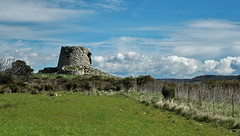 Image by cristianocani via Flickr
Image by cristianocani via FlickrBy Marcus Smith
The island of Sardinia is a very popular travel destination with both Italians from the mainland and with visitors from across Europe.
It is situated east of Italy, in the Mediterranean Sea, just a few kilometres south of the French island of Corsica. The climate is quite hot in the summer, mild but rarely cold in the winter, making it a popular destination all year round.
Sardinia is a destination with two facets: the popular, well known, side to the island focusing on beaches, harbours and Italian sophistication; and the less known interior of the island where quiet hill villages that have been little affected by tourism carry on life much as they have for several centuries.
Occupied and invaded numerous times over the last 2500 years, Sardinia also bears the traces of many different rulers. The Ancient Greeks, the Carthaginians and Romans, then later the Arabs, Byzantines and Spaniards have all left their mark on the island and helped to shape the unique culture that we see today.
Remnants of one civilisation that you will see signs of across the island is a great mystery. Known as the Nuraghe people, they established homes, fortresses and other temples and tombs in various remote and unwelcoming parts of the island, traces of many of which can still be seen today.
More recent but equally interesting is the very high number of churches scattered across the island. Many of the small towns seem to have almost as many churches as houses, typically dating from the 16th to 18th centuries. Not usually stunning in their architecture, they have a calm, simple design that suits the unchanging Sardinian landscape very well.
While the resorts of the Costa Smerelda region are crowded with sophistication and big spending holidaymakers, and the more glamorous parts of the coast are very beautiful (and crowded) many parts of the island - especially in the deep forested valleys of the interior - can provide a rare glimpse of a different Sardinia, equally worth discovering, where olive trees and vineyards cling to the edges of granite slopes and small streams and lakes provide a scenic backdrop. Explore these sleepy villages in the height of summer and you will often have the place to yourself, with no visible trace of either the locals or other tourists.
Whichever 'Sardinia' you choose to visit there is plenty to discover and enjoy, but try and find time during your visit to explore the other side of the island by hiring a car and going exploring for a couple of days, or finding an organised trek into the mountainous interior.
Learn more about the popular Costa Smerelda region, or some of the more out of the way places in Sardinia before you visit to make the most of your trip to this Mediterranean island.
Article Source: http://EzineArticles.com/?expert=Marcus_Smith
http://EzineArticles.com/?Visit-Sardinia&id=3551656
Search Amazon.com for Vino Con Vista Travel Books
